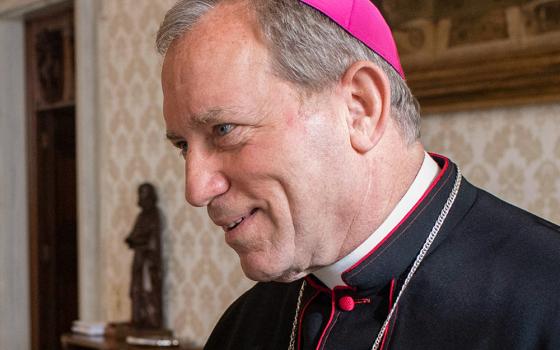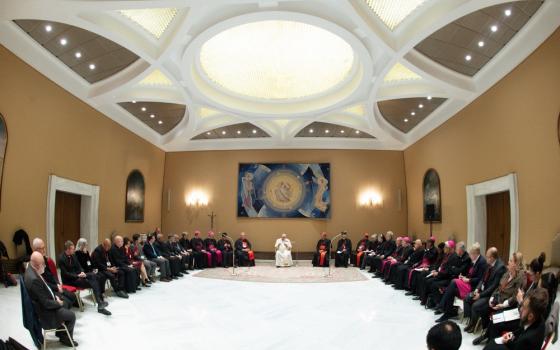
WASHINGTON (CNS) -- The retirement this spring of Supreme Court Justice John Paul Stevens leaves the court without its strongest critic of the death penalty.
Just 10 days before his 90th birthday, Stevens announced April 9 that he would step down at the end of the term this summer. His departure will provide President Barack Obama with his second opportunity to name a Supreme Court justice. Justice Sonia Sotomayor replaced Justice David Souter when he retired last June.
Obama was to host a meeting at the White House April 21 with key Republican and Democratic senators to discuss the vacancy. He is expected to announce a nominee quickly, with the goal of seating the new justice by the opening of the court's new term in October.
Stevens' career on the court has included more than 3,500 opinions, including some on which his views have shifted during his 35-year career, notably on capital punishment.
He also wrote some of the court's significant opinions or dissents on First Amendment issues including prayer in schools, obscenity and public display of the Ten Commandments. On abortion-related cases, his was a consistent vote to uphold Roe v. Wade and limit efforts to regulate abortion.
A 2005 ruling Stevens wrote for the majority in Gonzales v. Raich is the oft-cited legal standard for defending the new health reform law against claims that the federal government may not impose a national health care plan on the states. In that case, the court upheld the federal government's right to restrict the cultivation of marijuana even in states where it is legal for some medical uses, under the protection of the Commerce Clause of the Constitution.
On the death penalty, in 1976, months after he joined the court, Stevens co-wrote the main opinion that allowed the reinstatement of capital punishment. But in 2008 in an opinion that ultimately upheld Kentucky's method of lethal injection, Baze v. Rees, Stevens asked whether the time has come to reconsider "the justification for the death penalty itself."
He also wrote rulings or concurring opinions in cases that found the death penalty unconstitutional for juveniles and for people who are mentally retarded.
Stevens joined the court after the 1973 Roe v. Wade ruling that legalized abortion, but in subsequent cases he has consistently supported rulings to keep abortion legal and opposed efforts to regulate or limit the conditions for obtaining an abortion.
In the 1992 case, Planned Parenthood v. Casey, Stevens was among the majority that upheld the central holding of Roe v. Wade. He also was among the justices in that highly fragmented collection of opinions that found unconstitutional Pennsylvania's law seeking to limit the circumstances under which abortions are provided, such as a requirement that spouses be notified of a woman's intent to have an abortion.
Like the change in his views on the death penalty, in one area of First Amendment cases, Stevens also had a shift of opinion over the years. In the 1970s he upheld efforts by the city of Detroit to bar adult theaters in certain areas of town. By 2002, he said in a dissenting opinion over a law limiting pornography in ACLU v. Ashcroft that he was uneasy with regulating free speech even as a justification for protecting children from prurient materials.
Other aspects of the First Amendment on which Stevens wrote significant opinions included his majority opinion in Wallace v. Jaffree in 1985 tossing out Alabama's requirement of a minute of silence in public schools for "meditation or silent prayer." In that case he wrote that the court had "unambiguously concluded that the individual freedom of conscience protected by the First Amendment embraces the right to select any religious faith or none at all."
Twenty years later, Stevens dissented from a majority that ruled in Van Orden v. Perry that a display of the Ten Commandments on the grounds of the Texas Statehouse was constitutional. In his dissent, he said Texas had implicitly endorsed "the divine code of the 'Judeo-Christian' God." He argued that the Establishment Clause demands religious neutrality by government, including by not displaying religious symbols on public property.
And it was Stevens who in 2004 threw out a California man's attempt to stop schoolchildren from reciting the Pledge of Allegiance in class because it contains the words "under God." In his majority ruling, Stevens said the plaintiff lacked legal standing to challenge the pledge on behalf of his daughter, over whom he did not have legal custody.
In another case that drew a great deal of attention from Catholic dioceses and schools, Stevens dissented from the majority that ruled in 2002 that Cleveland's school voucher program is "entirely neutral with respect to religion." A majority of the students who receive the vouchers use them to attend Catholic schools, which led opponents of the program to charge that it constitutes state support of religion.
Stevens argued in his dissent from the 5-4 ruling that the majority decision was "profoundly misguided." He likened the ruling to taking a step toward religion-based strife such as that which led the first colonists to migrate to the New World from Europe or which has torn apart the Balkans, Northern Ireland and the Middle East.
"Whenever we remove a brick from the wall that was designed to separate religion and government, we increase the risk of religious strife and weaken the foundation of our democracy," Stevens wrote.



